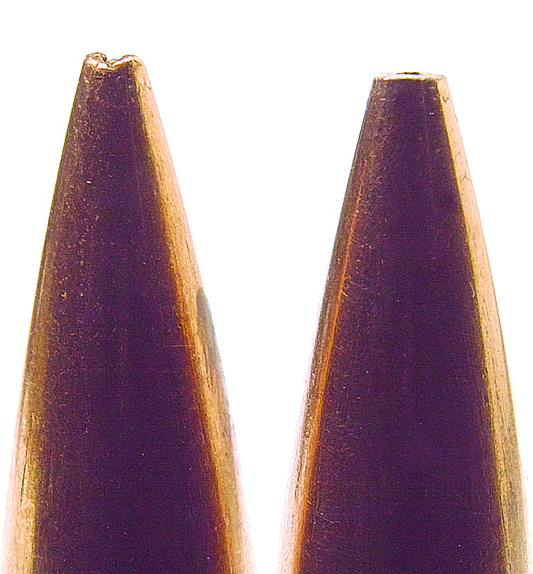Ballistic coefficient is a term that’s often used but sometimes not fully understood. Keep reading to find out exactly what it is, and what it isn’t…. HERE

Glen Zediker
A “ballistic coefficient,” or “BC,” is a number that suggests a bullet’s aerodynamic performance.
BC is a component in bullet design that matters much, and it matters more the farther it travels. Bullets that flat out fly, fly flat far out, are of great interest to any longer-range shooter. A bullet with a high(er)-BC is also an advantage at shorter distances, especially when there are variations in the shooting distance. A flatter-shooting (one of the traits supported by a higher BC) bullet means a more flexible zero, a smaller difference in the elevation hold from, say, 100 to 300 yards. BC is influenced by sectional density, bullet weight, and, mostly, its shape or profile.
BCs are derived by comparison. Here’s how that works: There are “standard” bullets that are mathematical models. Bullet designers and ballisticians know which model to apply to different bullet styles. Pistol bullets, for instance, are calculated from (compared to) different models. For the majority of rifle bullets we’ll encounter, one common model is a “G1” (there are others, like G7, which is becoming the popular standard for boat-tail bullets; G1 is based on a flat-base). The flight of this G1 bullet has been calculated at varying velocities and distances. It’s “all math” because a G1 doesn’t exist in a tangible sense.

The standard bullet has a BC of 1.000. An actual bullet that’s compared to, for example, the G1 at points, distances downrange, will either be flying faster or slower than the G1 model. If it’s faster, its BC will be greater than 1.000; if it’s slower, it will be less than 1.000. So it’s a percentage of the standard or model bullet’s performance.
Comparing bullets with different BCs, the one with the higher number loses less speed over distance. Losing less speed means its flight time will be shorter and it won’t drift and drop as much as will a bullet with a lower BC. So, a 0.600 flies better than a 0.550.
Depending on the bullet-maker, assigned or published BCs are either calculated or measured. More mathematics than I can wrap my mind around can get these calculations done based on a blueprint. Measured BCs involve chronographing at the muzzle and then at other points on downrange, same bullet, same flight.
Which method — math or measure — provides the best information? Some, and this only “makes sense,” believe that a measured, tested BC is more realistic and, therefore, more valuable. But, if the point is to compare bullets, calculated BCs might be more reliably accurate. I know a number of very serious NRA High Power shooters who have gone to great lengths to “field test” different bullets. It’s not easy to chronograph at long range. Given that information, measured BCs are quite often lower, but not nearly always. Reasons follow.
All the drift and drop tables (whether printed or digital) you’ll see are based on a bullet’s assigned BC. The accuracy of those tables clearly revolves around what the actual, at that moment, BC performance is from the bullet you’re shooting. Also, some bullets have a different stated BC based on muzzle velocity to start.
A whopping lot of things affect the actual, demonstrated BC: anything that can influence bullet flight influences the actual BC performance.
Bullet stability is a factor. For a stated BC to be shown on a shot, the bullet has to be “asleep.” If it’s not stable, it’s encountering disruptions that will slow it down. The rotational speed of a bullet in a test can influence BC. We’ve seen differences comparing different twist-rate barrels, and the faster twists often show a little lower BC outcome.
Atmospherics, which add up as a list of factors, influence BC mightily. Air density is probably the most powerful influence. Any conditions that allow for easier passage of a bullet through the air don’t detract as much from its BC as do any conditions that serve to hinder its flight. BCs are based on sea-level so can easily show as a higher number at a higher elevation.

Range-realized reality is that the demonstrated BC changes from morning to afternoon and day to day and place to place. The calculated BC is not changing, of course, but the mistake is assuming that a BC is a finite measure of bullet performance. If you’re interested, there’s some valuable information from David Tubb (visit DavidTubb.com). He’s done a volume of work on calculating influences from atmospherics as it applies to his DTR project, which, in one way of seeing it, gets down to understanding why it’s really rare to dial in what a ballistics table says for a particular bullet and speed and distance, and hit the target.
One last (for now) bit of information I’ve always found valuable: a BC is a finite thing in one regard, and that is that any BC derived from a G1 model, for instance, fits all bullets with that same BC. This was helpful before ballistics apps were as common and easy as they are now. For instance, if there was a new .224-caliber bullet with an advertised BC, but no tables, just find another bullet, of any caliber, with that same BC, plug in the velocity, and the drift and drop figures will be accurate.
The information in this article is from Glen’s newest book, Top-Grade Ammo, available HERE at Midsouth. Also check HERE for more information about this and other publications from Zediker Publishing.









